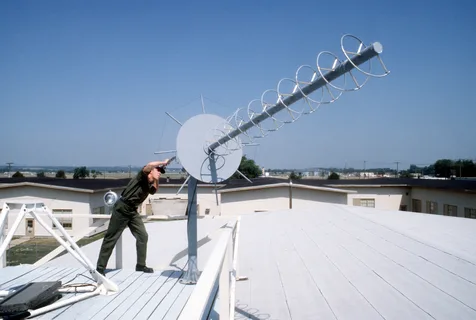A team of researchers from Stanford University and the American University of Beirut (AUB) has developed a lightweight, portable antenna that could revolutionize communication in disaster-prone areas. Traditional communication infrastructure, such as cell phone towers and radio towers, are often damaged or destroyed during earthquakes, floods, and other disasters, making it difficult to coordinate rescue and relief efforts. The new antenna offers a solution by providing a quick and efficient way to set up communication networks in such areas.
The portable antenna, recently described in Nature Communications, is designed to be easily deployed and used in disaster-prone regions or underdeveloped areas. Unlike the heavy, metallic dishes typically used in these scenarios, the new antenna is lightweight, consumes less power, and can switch between two operating states. This versatility allows it to communicate with satellites or devices on the ground without the need for additional power.
The researchers used a method commonly employed in designing technology for space to develop the antenna. In space missions, technology must be lightweight and compact due to fuel and space limitations. Similarly, the antenna was designed to be collapsible and lightweight, making it highly portable and easy to transport to disaster zones.
The antenna, made of fiber composites, resembles a child’s finger-trap toy with multiple spiraling strips of material. By adjusting the structure, the researchers can modify the pattern and power of the signals sent out by the conductive material running through the antenna. The antenna can collapse into a packable shape, measuring just over 1 inch tall and about 5 inches across, weighing only 1.4 ounces. In this compact form, it can send high-power signals to satellites in a specific direction. When extended to about a foot tall, the antenna sends lower-power signals in all directions, similar to a Wi-Fi router.
Shifting between these two states is as simple as pulling or pushing on the antenna. The structure snaps into place once it is moved past a certain point, eliminating the need for precise movements. The specific size and shape of the antenna determine the frequencies over which it can communicate in each state.
The team tested the fabricated prototype at Stanford for deployment and structural performance, while the antenna measurement facilities at AUB were used to evaluate its electromagnetic radiation characteristics. To deploy the antenna in the field, it would need to be paired with a transceiver for sending and receiving signals, a ground plane to reflect radio waves, and other electronics. However, the whole package would still weigh only about 2 pounds.
The antenna’s lightweight design and dual functionality make it ideal for deployment in disaster-stricken and underdeveloped areas. It has the potential to replace multiple heavy antennas in challenging deployment scenarios. Additionally, the researchers are exploring the possibility of adapting the design for satellite communications. This could allow satellites to use a single antenna to communicate with each other and with the ground, reducing the need for multiple antennas on a satellite.
The development of the portable antenna marks a significant advancement in restoring communication in disaster zones. Its lightweight design, ease of deployment, and versatility make it a promising solution for quickly establishing communication networks in areas affected by disasters. As further research and development are conducted, this innovative antenna could have a profound impact on coordinating rescue and relief efforts worldwide, both in disaster zones and in space missions.
*Note:
1. Source: Coherent Market Insights, Public sources, Desk research
2. We have leveraged AI tools to mine information and compile it



